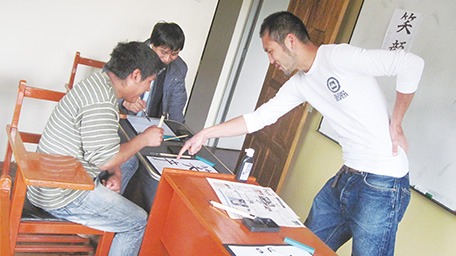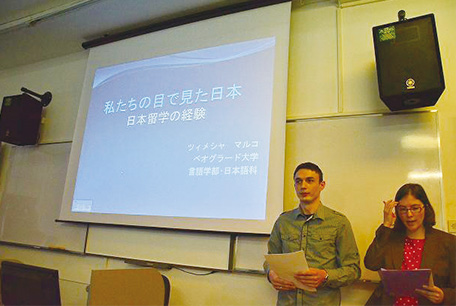Japan's Official Development Assistance White Paper 2013
(5) Cultural Preservation and Promotion
In developing countries, more people are interested in the preservation and promotion of their own cultures. For example, cultural heritages that symbolize a country are not only the source of pride for its people, but can also be used effectively as sightseeing resources to develop the society and economy of the residents of surrounding areas. However, many of the cultural heritages of developing countries are at risk, and support to protect those cultural heritages can be viewed as cooperation that goes direct to people’s hearts, and has long-term impacts. In addition, the preservation and promotion of the culture such as the precious cultural heritages that are shared by all humankind is an issue that not only developing countries should be dealing with, but the entire international community as well.
<Japan’s Efforts>
Since 1975 Japan has continued to contribute to the promotion of cultural and higher educational activities and preservation of cultural heritages of developing countries with Cultural Grant Assistance*. Specifically, Japan has implemented construction of the facilities for the preservation and use of the cultural heritages and cultural properties, sports and cultural facilities, higher education and research organization facilities, and improvement of necessary equipment in the said facilities. The equipment and facilities provided to developing countries are also used as bases for providing information of Japan, and for cultural exchange, and would deepen the understanding of Japan and fostering a sense of affinity towards Japan. In recent years, from the viewpoint of “Japan Promotion,” Japan has also put importance on support for Japanese language education.
In FY2012, Japan provided assistance for a wide variety of education sectors, mainly higher education in the Japanese language, physical education, music, etc. It supported the development of Japanese language learning facilities in Sudan and Serbia. In addition, Japan provided assistance for the provision of sport facilities and equipment in Ghana, Lebanon, and Moldova, as well as providing support for music academies in Angola and Colombia. Furthermore, Japan supported the improvement of equipments for producing educational media programs of the Education Media Center in Papua New Guinea.
Japan has contributed to restoration and preservation of cultural heritages, including equipment provision and preliminary studies and surveys through “Japanese Funds-in-Trust for the Preservation of the World Cultural Heritage” established in UNESCO. Stressing the importance of capacity building, Japan also has been providing assistance through dispatching international experts which mainly include Japanise experts as well as holding workshops in order to transfer techniques and knowledge to developing countries. Japan also has been supporting for intangible cultural heritages such as traditional dances, music, handcraft techniques, oral traditions by implementing projects of successors training, records conservation and other activities through “Japanese Funds-in-Trust for the Safeguarding of the Intangible Cultural Heritage” established in UNESCO.

A Japan Overseas Cooperation Volunteer teaching Japanese calligraphy to students who are learning the Japanese language in Peru. (Photo: Hiroshi Isaki / JICA)
Glossary
- *Cultural Grant Assistance
- Cultural Grant Assistance provides the funding to contribute to the promotion of cultural and higher educational activities and preservation of cultural heritage in developing countries. (procurement of equipment, construction of facilities, etc.) There are two types: “General Cultural Grant Assistance,” which is provided to governmental organizations, and “Grant Assistance for Cultural Grassroots Projects,” which is provided to NGOs and local public entities for small-scale projects.
●Serbia
The Project for the Improvement of Language Laboratory for the Division of Japanese Language and Literature, Faculty of Philology, University of Belgrade
Cultural Grant Assistance (Grant Assistance for Cultural Grassroots Projects) (February - June 2012)
Serbia is believed to have one of the largest Japanese language student populations of all the former Yugoslav nations. However, the University of Belgrade is the only higher education institution offering a degree in Japanese language and Japanese culture. The University first began offering Japanese language courses in 1976 and offers the most systemic Japanese language program in Serbia. The university has been fostering human resources that serve as a bridge between Japan and Serbia. Most of the instructors at Japanese language education institutions across Serbia are graduates of the University of Belgrade.
Despite being the leading provider of Japanese language education in Serbia, the equipment used at the language laboratory dated back to the 1980s, and most of them were out of operation. As the University was not able to allocate a sufficient budget to update the laboratory, Japan provided assistance to renovate the laboratory and enhance the learning environment through the Grant Assistance for Cultural Grassroots Projects. Following the renovation of the language laboratory, the number of prospective students increased, and the enrollment of new students at the department of Japanese language and literature increased by 20% over the previous year. Furthermore, many Serbian students returning from their studies in Japan are continuing their studies in the university’s master’s program.
The University of Belgrade plans to strengthen exchanges with Japanese universities. It is anticipated that the University will produce many graduates with advanced Japanese proficiency who will serve as bridges between Japan and Serbia.

University of Belgrade students reporting on their studies in Japan using the newly installed equipment. The presentations were made in both Japanese and Serbian.

University of Belgrade students listening intently to the presentations of students who returned from Japan. The PCs, desks, and chairs were furnished by the project. (Both photos: Embassy of Japan in Serbia)

Mr. Uchijima, a Japan Overseas Cooperation Volunteer, teaches at four Japanese schools in the northern region of the Dominican Republic, visiting each school once a week. (Photo: Koji Sato / JICA)
